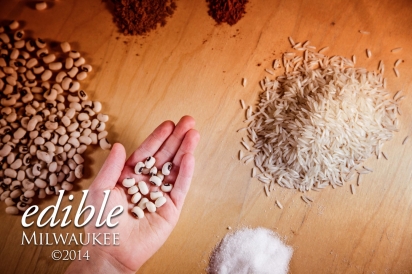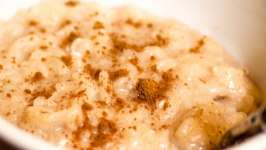Cooking Up a Lucky New Year
Global New Year’s food traditions to try as a family
While waiting for the clock to strike midnight, families around the world gather together to celebrate the year past and look forward to another together. Toasts are made, resolutions planned, and food is enjoyed while ringing in the New Year.
While the countries and cultures may vary, one common thread between these celebrations is that many include traditional foods and dishes that are deemed lucky, or if prepared in a certain way, hold the promise of a prosperous year ahead.
From beans to greens, we have compiled a list of lucky ingredients and New Year’s food traditions from around the world.
Hopefully your clan will create a new tasty tradition, and be inspired to “add cooking more as a family” to your resolution list!
Legumes
From black-eyed peas to lentils, many different varieties of legumes are consumed all around the world at midnight.
In the American South, black-eyed peas are considered lucky to eat due to their abundance and penny–like appearance. Hoppin’ John—a traditional Southern New Year’s dish—is made from black-eyed peas, rice, and bacon or ham hock. Hoppin’ John leftovers are kept and enjoyed the next day, at which point they are called Skippin’ Jenny, and represent frugality and humility, qualities that will lead to prosperity in the year to come. Hoppin’ John is also often served with cornbread, a side dish lucky on its own—the golden color is reminiscent of a bar of gold.
Lentils are considered lucky for a few reasons. Not only is their coin-like shape representative of prosperity, but these seeds swell when cooked, acting as another indicator of growing wealth in the coming year. In Brazil, the first meal of the New Year is traditionally a lentil soup. Both Germans and Italians partner lentils with pork sausage, a meat with its own lucky associations. For Chileans, it doesn’t matter how they are prepared, any type of lentils are said to bring good fortune!
Pork
In many cultures around the world, pigs symbolize progress, a quality that stems from the animal’s eating habit of pushing their snout forward along the ground when looking or “rooting” for food. The rotund figure and high fat content of pigs also represent wealth and prosperity.
From traditional preparations of sausage in Europe to jerk pork in Jamaica, pigs are enjoyed in many forms during holiday celebrations. Not a meat eater? Try making pig-shaped cookies or even serving pig-shaped marzipan, as is tradition in parts of Austria and Germany.
Greens
Greens are a popular dish during celebrations worldwide because, simply stated, they look like money. It’s said that the more greens you eat, the more prosperous you’ll be—not to mention healthier, too! Eastern Europeans enjoy sauerkraut made from cabbage, while the Danish enjoy stewed kale topped with cinnamon and sugar. In the South, collard greens are often prepared with pork and black-eyed peas for a trifecta of prosperity.
Noodles
In Japan, soba, or buckwheat noodles, are eaten at midnight and symbolize longevity, but be careful not to break the noodles when eating or your long life will be cut in half! Kids, this is the one time it is okay to slurp your noodles; in Japan, slurping also signifies enjoying the meal!
Circular Baked Goods
While enjoyed at many holidays and celebrations throughout the year, round or ring-shaped baked goods are considered special at New Year’s as they represent prosperity and coming full circle. Doughnuts and circular cookies are commonplace at celebrations around the world. Try baking a favorite holiday cake in a Bundt, or making a ring-shaped cornbread or round pork meatloaf for double the prosperity.
Fruit
In Spain and many former Spanish colonies, 12 grapes are consumed at the stroke of midnight, one for each stroke of the clock, as well as month in the year to come. As each grape represents a month, the flavor and quality of each serves as a predictor for the corresponding month ahead. For example, if you have a sweet 6th and 7th grape, but a tart 8th, you are destined to have an enjoyable start to the summer, but a sour August.
There are two traditions for enjoying grapes at midnight. The first is to eat the grapes slowly, noting their flavor and indications for the year ahead. The second way is to keep pace with the clock, eating one grape for each stroke, with the goal of consuming all before the last stroke of midnight. The second challenge is a fun activity for older children but we recommend enjoying the grapes at a slow pace with little ones—also a symbolic lesson on savoring the year ahead.
Greeks celebrate with another round fruit at midnight: pomegranates! These lucky fruits are used for more than just eating though. At midnight, Greek families exit their homes, removing the pomegranate that has been hanging from their door since Christmas. One lucky family member is chosen to smash the fruit against the door, exploding it and exposing the abundance of little red seeds that represent prosperity in the year ahead.
Hidden Fortune
In many cultures, it is customary to hide a coin or trinket inside dessert. The finder of this prize will then have good fortune for the year to come. In Mexico a ring-shaped cake with candied fruit called rosca de reyes is baked with a surprise inside. In Sweden and Norway, almonds are hidden inside rice pudding, guaranteeing the finder luck for the next 12 months.
Fish
There are about as many reasons why fish is considered a lucky New Year’s food as there are many traditional preparations for it during holiday celebrations.
In many Scandinavian countries, as well as Poland and Germany, pickled herring is enjoyed at midnight to ensure a year of abundance, as herring is bountiful in those regions, swimming in large schools. Shiny silver fish scales also resemble silver coins and are sometimes placed in wallets for monetary luck in the year to come.
For many other cultures that celebrate with fish, it is important it be served head to tail to ensure a good year from start to finish.
Caution! Stay away from eating lobster as the clock strikes midnight as this crustacean swims backward and is believed to cause eaters to move back into bad habits during the next year!








